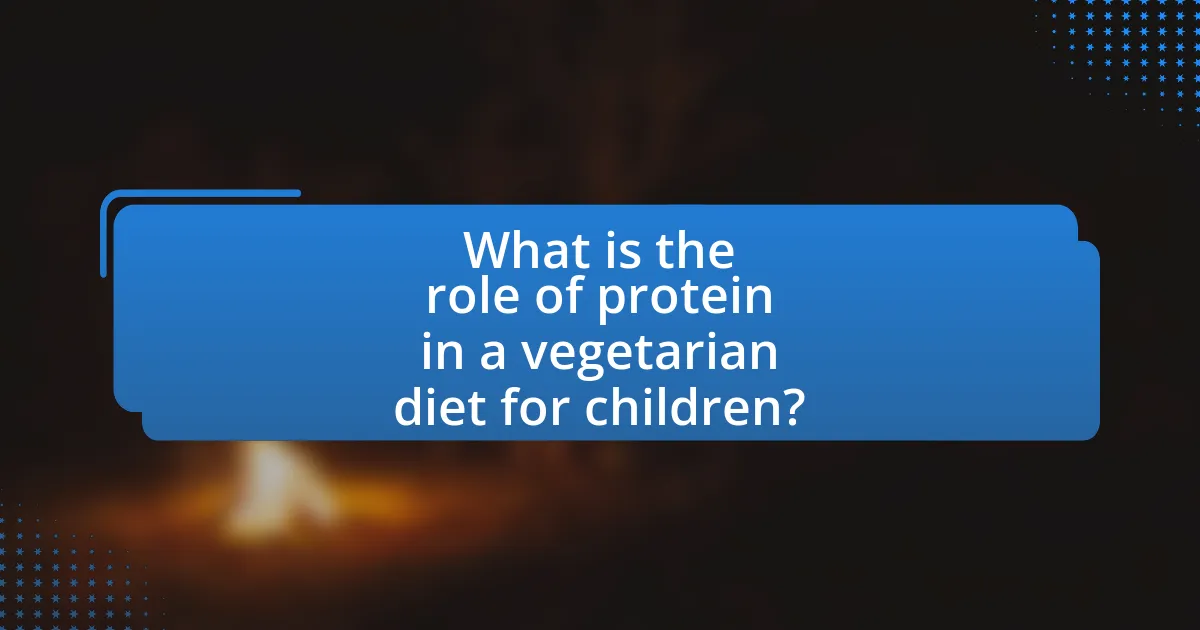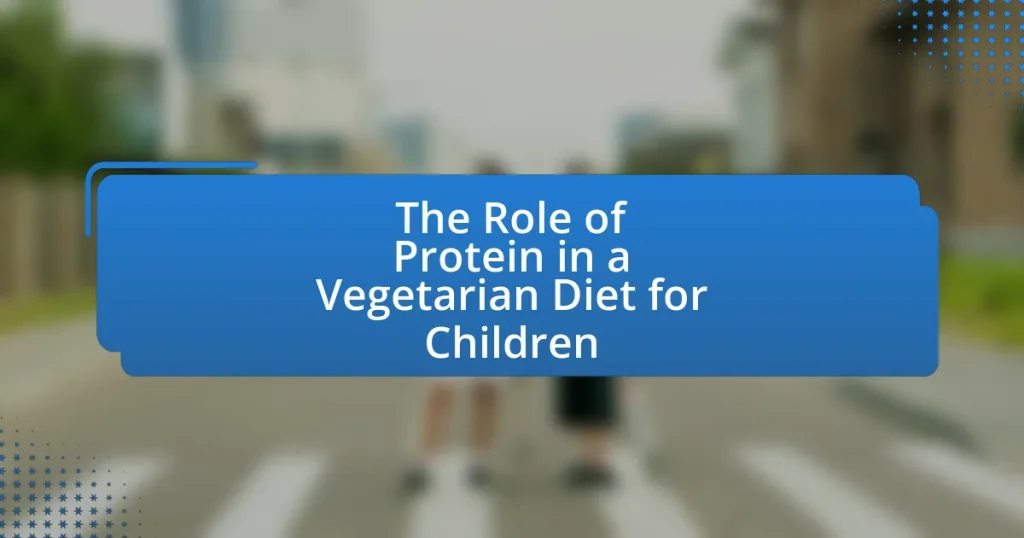The article focuses on the critical role of protein in a vegetarian diet for children, emphasizing its importance for growth, development, and overall health. It outlines how protein supports tissue building, immune function, and muscle repair, while detailing recommended daily protein requirements for various age groups. The article also identifies key vegetarian protein sources, such as legumes, nuts, seeds, and whole grains, and discusses strategies for parents to ensure their children meet protein needs through diverse meal planning. Additionally, it addresses potential challenges vegetarian children may face regarding protein intake and highlights the significance of other essential nutrients in a balanced vegetarian diet.

What is the role of protein in a vegetarian diet for children?
Protein plays a crucial role in a vegetarian diet for children by supporting growth, development, and overall health. It is essential for building and repairing tissues, producing enzymes and hormones, and maintaining a strong immune system. Vegetarian sources of protein, such as legumes, nuts, seeds, and whole grains, provide the necessary amino acids that children need for their physical and cognitive development. Research indicates that children on vegetarian diets can meet their protein needs effectively when they consume a variety of these plant-based foods, ensuring they receive all essential amino acids.
Why is protein essential for children’s growth and development?
Protein is essential for children’s growth and development because it provides the necessary building blocks for the formation of muscles, tissues, and organs. During childhood, the body undergoes rapid growth, and protein supports this process by facilitating cell repair and regeneration. Research indicates that adequate protein intake is crucial for maintaining a healthy immune system and promoting overall physical development. For instance, the World Health Organization recommends that children aged 1-3 years consume about 13 grams of protein daily, while those aged 4-8 years should have around 19 grams. This dietary requirement underscores the importance of protein in ensuring that children achieve their growth milestones and maintain optimal health.
What are the key functions of protein in a child’s body?
Proteins play essential roles in a child’s body, primarily in growth, development, and overall health. They are crucial for building and repairing tissues, producing enzymes and hormones, and supporting immune function. For instance, during childhood, protein intake is vital as it contributes to the development of muscles, bones, and organs, which are rapidly growing. Additionally, proteins are involved in the synthesis of antibodies, which help protect against infections. Research indicates that adequate protein consumption is linked to improved growth outcomes in children, emphasizing its importance in a balanced diet.
How does protein contribute to muscle development and repair?
Protein is essential for muscle development and repair as it provides the building blocks, known as amino acids, necessary for muscle tissue synthesis. When children engage in physical activities, muscle fibers undergo stress and damage, prompting the need for repair. Protein intake stimulates muscle protein synthesis, which is crucial for recovery and growth. Research indicates that adequate protein consumption can enhance muscle mass and strength, particularly in growing children. For instance, a study published in the American Journal of Clinical Nutrition found that children who consumed sufficient protein showed improved muscle development compared to those with lower protein intake.
What are the sources of protein in a vegetarian diet?
Sources of protein in a vegetarian diet include legumes, nuts, seeds, dairy products, eggs, and whole grains. Legumes such as lentils, chickpeas, and beans are rich in protein and provide essential amino acids. Nuts and seeds, including almonds, walnuts, chia seeds, and flaxseeds, also contribute significant protein content. Dairy products like milk, yogurt, and cheese offer high-quality protein, while eggs are a complete protein source for those who include them in their vegetarian diet. Whole grains such as quinoa, brown rice, and oats provide additional protein and are important for a balanced diet. These sources collectively ensure adequate protein intake for children following a vegetarian diet.
Which plant-based foods are high in protein?
Legumes, such as lentils and chickpeas, are high in protein, providing approximately 18 grams of protein per cooked cup. Additionally, quinoa offers about 8 grams of protein per cooked cup and is a complete protein, containing all nine essential amino acids. Tofu, made from soybeans, contains around 20 grams of protein per cup, making it a versatile protein source. Furthermore, edamame, or young soybeans, provides about 17 grams of protein per cup when cooked. Nuts and seeds, including almonds and pumpkin seeds, also contribute significantly, with almonds containing about 6 grams of protein per ounce and pumpkin seeds offering around 7 grams per ounce. These foods are essential for ensuring adequate protein intake in a vegetarian diet for children.
How can legumes and pulses be incorporated into meals?
Legumes and pulses can be incorporated into meals by adding them to salads, soups, stews, and as side dishes. For instance, chickpeas can enhance salads with protein and fiber, while lentils can be used in soups for a hearty texture and nutritional boost. Additionally, black beans can serve as a filling in tacos or burritos, providing essential amino acids. Research indicates that legumes and pulses are rich in protein, making them an excellent choice for vegetarian diets, particularly for children who require adequate protein for growth and development.
How can parents ensure adequate protein intake for vegetarian children?
Parents can ensure adequate protein intake for vegetarian children by incorporating a variety of plant-based protein sources into their diets. Foods such as legumes (beans, lentils, chickpeas), nuts, seeds, whole grains (quinoa, brown rice, oats), and dairy or dairy alternatives (if not vegan) provide essential amino acids necessary for growth and development. Research indicates that a well-planned vegetarian diet can meet protein needs; for instance, the American Dietetic Association states that vegetarian diets can provide sufficient protein when diverse food sources are included. By combining different protein sources, such as rice and beans, parents can create complete proteins, ensuring their children receive all essential amino acids.
What are the recommended daily protein requirements for children?
The recommended daily protein requirements for children vary by age. For children aged 1-3 years, the requirement is approximately 13 grams of protein per day. For children aged 4-8 years, the requirement increases to about 19 grams per day. As children grow, those aged 9-13 years need around 34 grams of protein daily, while teenagers aged 14-18 years require about 46 grams for females and 52 grams for males. These recommendations are based on guidelines from the Dietary Reference Intakes established by the National Academies of Sciences, Engineering, and Medicine, which provide a framework for adequate protein intake to support growth and development in children.
How can meal planning help meet protein needs?
Meal planning can help meet protein needs by ensuring that meals are strategically designed to include adequate protein sources. By organizing meals in advance, individuals can incorporate a variety of protein-rich foods such as legumes, nuts, seeds, dairy, and whole grains, which are essential for a balanced vegetarian diet. Research indicates that children require sufficient protein for growth and development, and meal planning allows caregivers to monitor and adjust protein intake effectively, ensuring that daily requirements are met. For instance, the Recommended Dietary Allowance (RDA) for protein in children varies by age, and meal planning can help align food choices with these guidelines, promoting optimal health outcomes.
What challenges might vegetarian children face regarding protein intake?
Vegetarian children may face challenges in meeting their protein intake due to limited access to complete protein sources. Unlike omnivorous diets, vegetarian diets often lack certain essential amino acids found in animal products, which can lead to potential deficiencies if not properly managed. Research indicates that children require adequate protein for growth and development, and a study published in the Journal of the American Dietetic Association highlights that vegetarian children may struggle to consume sufficient protein without careful meal planning. This underscores the importance of incorporating a variety of plant-based protein sources, such as legumes, nuts, seeds, and whole grains, to ensure they receive all essential amino acids.
How can parents address potential protein deficiencies?
Parents can address potential protein deficiencies in their children by incorporating a variety of protein-rich vegetarian foods into their diets. Foods such as legumes, nuts, seeds, whole grains, and dairy products provide essential amino acids necessary for growth and development. For instance, lentils contain about 18 grams of protein per cooked cup, while quinoa offers approximately 8 grams per cooked cup, making them excellent sources of plant-based protein. Additionally, combining different protein sources, like rice and beans, can create a complete amino acid profile, ensuring children receive all necessary nutrients. Regularly monitoring dietary intake and consulting with a healthcare professional can further help parents ensure their children meet their protein needs effectively.
What signs indicate that a child may not be getting enough protein?
Signs that indicate a child may not be getting enough protein include stunted growth, fatigue, frequent infections, and muscle weakness. Stunted growth occurs because protein is essential for tissue development and repair; without adequate protein, a child’s growth may be hindered. Fatigue can result from insufficient protein intake, as protein is vital for energy production and overall vitality. Frequent infections may indicate a weakened immune system, which can be linked to inadequate protein levels, as proteins play a crucial role in immune function. Muscle weakness is another sign, as protein is necessary for muscle maintenance and strength; a deficiency can lead to decreased muscle mass and strength.
How does a vegetarian diet impact overall nutrition in children?
A vegetarian diet can positively impact overall nutrition in children by providing essential nutrients while promoting healthy eating habits. This diet is often rich in fruits, vegetables, whole grains, and legumes, which contribute to higher intakes of dietary fiber, vitamins, and minerals. Research indicates that children following a vegetarian diet can meet their protein needs through plant-based sources such as beans, lentils, tofu, and quinoa, which are also lower in saturated fat compared to animal proteins. A study published in the Journal of the American Dietetic Association found that vegetarian children had similar growth patterns and nutritional status compared to their omnivorous peers, provided their diets were well-planned. This evidence supports the notion that a well-balanced vegetarian diet can support adequate nutrition and healthy development in children.
What other nutrients should be considered alongside protein?
Other nutrients that should be considered alongside protein in a vegetarian diet for children include iron, calcium, vitamin B12, and omega-3 fatty acids. Iron is crucial for preventing anemia and is found in legumes and fortified cereals. Calcium supports bone health and can be sourced from dairy products or fortified plant-based alternatives. Vitamin B12 is essential for nerve function and is primarily found in animal products, so supplementation or fortified foods are necessary for vegetarians. Omega-3 fatty acids, important for brain development, can be obtained from flaxseeds, chia seeds, and walnuts. These nutrients collectively ensure a balanced diet that supports the growth and development of children.
How can a balanced vegetarian diet support overall health?
A balanced vegetarian diet can support overall health by providing essential nutrients while reducing the risk of chronic diseases. This diet is typically rich in fruits, vegetables, whole grains, legumes, nuts, and seeds, which are high in fiber, vitamins, and minerals. Research indicates that individuals following a vegetarian diet have lower rates of heart disease, hypertension, type 2 diabetes, and certain cancers. For instance, a study published in the Journal of the American Heart Association found that vegetarian diets are associated with a 32% lower risk of heart disease compared to non-vegetarian diets. Additionally, a balanced vegetarian diet can help maintain a healthy weight, as it is often lower in calories and saturated fats.
What practical tips can help parents provide sufficient protein in vegetarian diets?
To ensure sufficient protein in vegetarian diets for children, parents should incorporate a variety of protein-rich foods such as legumes, nuts, seeds, dairy products, and whole grains. Legumes like lentils and chickpeas provide essential amino acids and can be easily added to soups, salads, or stews. Nuts and seeds, including almonds and chia seeds, serve as nutritious snacks or toppings for cereals and yogurt. Dairy products like milk, cheese, and yogurt are excellent sources of protein and can be included in meals and snacks. Whole grains such as quinoa and brown rice also contribute to protein intake and can be used as bases for various dishes. Research indicates that a diverse diet including these food groups can meet the protein needs of children, supporting their growth and development effectively.

